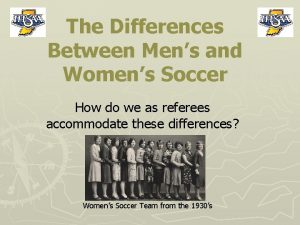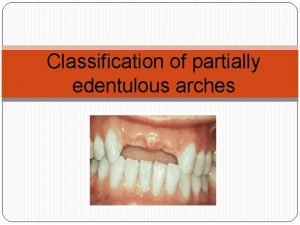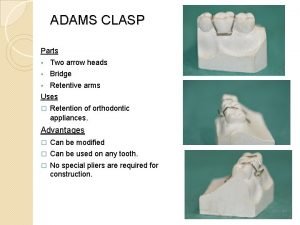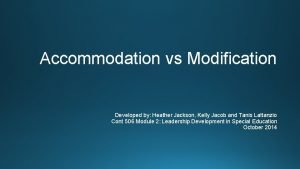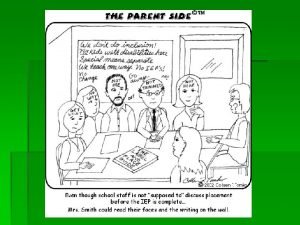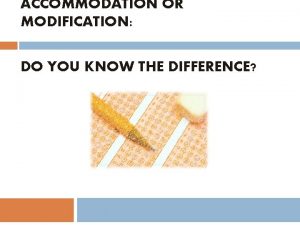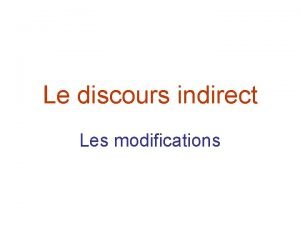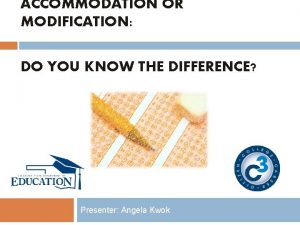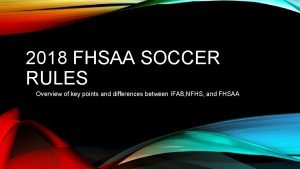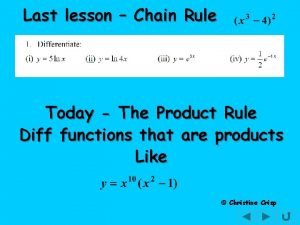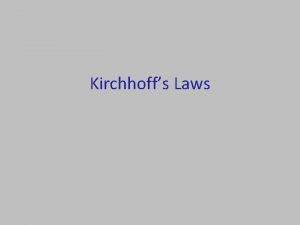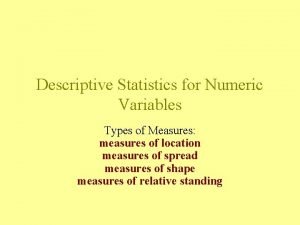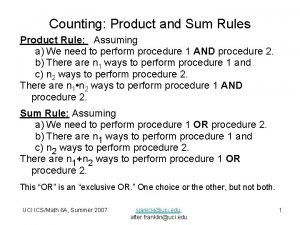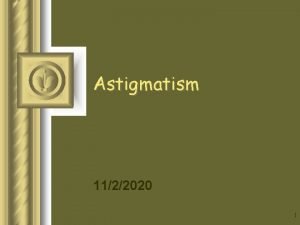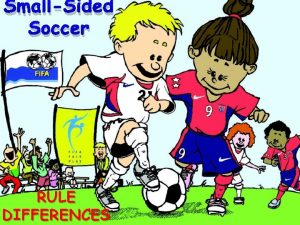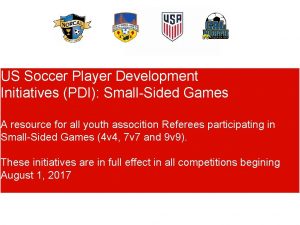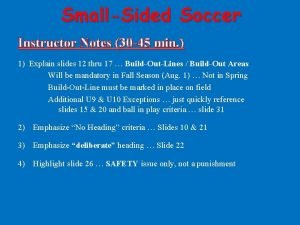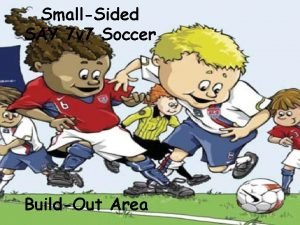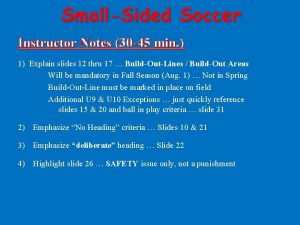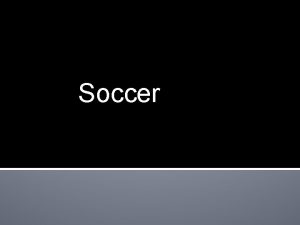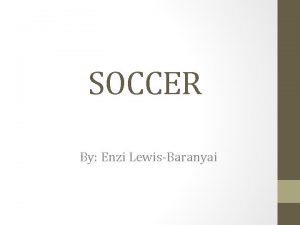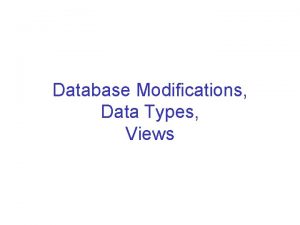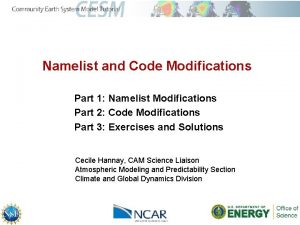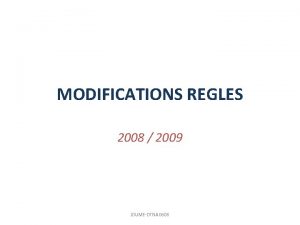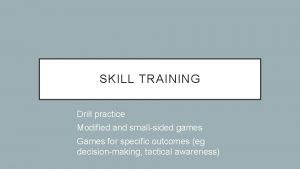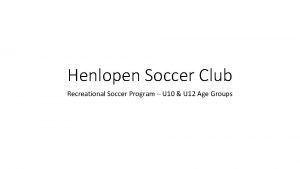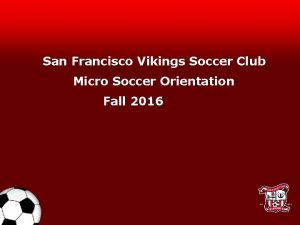SmallSided Soccer RULE DIFFERENCES SmallSided Soccer Rule Modifications




















- Slides: 20

Small-Sided Soccer RULE DIFFERENCES

Small-Sided Soccer Rule Modifications The Soccer Rule Differences contained in this presentation are based upon the latest recommended modifications by US Youth Soccer to the FIFA (USSoccer) Laws of the Game.


LAW 3 - NUMBER OF PLAYERS Full-Sided Games U 13 & Older: 11 v 11 players, one of whom must be the goalkeeper … (minimum of 7 players to continue) Small-Sided Games (Two different levels) U 11 & U 12: 9 v 9 players, one of whom must be the goalkeeper … (minimum of 6 players to continue) U 9 & U 10: 7 v 7 players, one of whom must be the goalkeeper … (minimum of 5 players to continue)

LAW 8 - START OF PLAY (Small-Sided) U 9 & U 10 (7 v 7) and U 11 & U 12 (9 v 9) As per FIFA / USSoccer Distance from the Ball (Until ball is in play): Kick-off Opponents U 9 & U 10 8 yds. U 11 & U 12 8 yds. U 13 & Older 10 yds.

LAW 11 – OFFSIDE (Small-Sided) U 11 & U 12 (9 v 9) Offside as per FIFA / USSoccer

LAW 11 – OFFSIDE (Small-Sided) U 9 & U 10 – (7 v 7) Offside as per FIFA / USSoccer Exception: Attacking players can only be in an offside position when they are between the build-out-line and the goal-line, i. e. within the Build-Out Area. Offside is not in effect between the half-line and the build-out-line.

LAW 12 – FOULS & MISCONDUCT (Small-Sided) U 11 & U 12 (9 v 9) All restarts are as per FIFA / USSoccer … DFK & IFK Any misconduct punished as per the Laws of the Game U 12 NOTE: Heading is allowed in games without limitations. U 11 NOTE: Heading is NOT allowed in games.

LAW 12 – FOULS & MISCONDUCT (Small-Sided) U 9 & U 10 (7 v 7) EXCEPTION #2: Goalkeepers are not allowed to punt or drop kick the ball. § An IFK is awarded to the opposing team at the spot of the offense. § If the punt occurs within the goal area, the IFK is to be taken on the goal area line parallel to the goal line at the nearest point to where the infringement occurred.

LAW 12 – FOULS & MISCONDUCT (Small-Sided) U 9 & U 10 (7 v 7) Restarts are as per FIFA / USSoccer … DFK & IFK Any misconduct punished as per the Laws of the Game EXCEPTION #1: Deliberate heading is not allowed.

LAW 13 – FREE KICKS (Small. Sided) The minimum distance that all opposing players must be from the ball at the taking of a free kick is the same as the “radius of the center circle”. 7 v 7 Center Circle Radius 8 yds. 9 v 9 8 yds. 11 v 11 10 yds.

LAW 14 – PENALTY KICK (Small-Sided) U 9 & U 10 (7 v 7) Penalty Spot is 10 yds. from the Goal Line U 11 & U 12 (9 v 9) Penalty Spot is 10 yds. from the Goal Line Full-Sided U 13 & Older (11 v 11) Penalty Spot is 12 yds. from the Goal Line

LAW 16 - GOAL KICK (Small -Sided) U 11 & U 12 (9 v 9) As per FIFA / USSoccer: § Opponents must be outside penalty area. § The ball is in play when it is kicked outside the penalty area and into play.

LAW 16 - GOAL KICK (Small -Sided) U 9 & U 10 (7 v 7) As per FIFA / USSoccer: U 9 & U 10 EXCEPTION: § Opposing players must retreat to behind the build-outarea until the ball is in play. § The ball is in play when it is kicked outside the penalty area and into play.

OSSRC Heading the Ball Restrictions 1) If a player in a U 11(9 v 9), U 10(7 v 7) or younger age group match deliberately heads the ball in a game with any portion of their head, an indirect free kick (IFK) is to be awarded to the opposing team from the spot of the infraction. 2) If the ball makes contact with a player’s head and the player has not deliberately played or attempted to play the ball, then play should continue as no infraction has occurred.

OSSRC Heading the Ball Restrictions 3) A player shall not be cautioned nor sent-off for persistent infringement, as a result of a heading infraction. 4) A player shall not be cautioned nor sent-off for denying an obvious goal scoring opportunity (DOGSO), as a result of a heading infraction. It is not a handling offense and it is not an offense committed against an opponent … therefore criteria for committing a DOGSO offense does not exist.

OSSRC Heading the Ball Clarifications § Heading of the ball is allowed in U 12 and older age group matches (9 v 9) without limitations. § Referees are to enforce the heading restrictions by age group of the team in accordance with these specified rules. § Referees will not be assessing the age of individual players on the field … they will only enforce the rules for the age group.

OSSRC Heading the Ball Clarifications § Advantage shall not be implemented when a heading infraction occurs which would allow play to continue. Exception: When a ball goes directly into the goal from a header by a defending player into their own goal (e. g. with no subsequent play on the ball) the goal should be awarded. This is the only time an advantage should be applied. § This rule is primarily a SAFETY issue, which needs to be addressed immediately, such that it does not occur again. § This is not an infraction where the player needs to be punished, i. e. with a caution or send-off. Again, it is a selfinflicted safety issue.

OSSRC Heading the Ball Clarifications § It may be acceptable to have the player leave the game (much like an injury) such that the coach can talk to the player. o This is not a mandate … solely at the discretion of the referee. o More likely to implemented, if deliberate heading is repeated. o Player would be allowed back in the game at the team’s next substitution time. o Again, this is not intended to be a punishment, but instead a teaching moment.

OSSRC Heading the Ball Explanations § As a referee or an AR you must determine if ball and head contact was a deliberate act by the player. q Ball to head … not deliberate q Head to ball … deliberate § Similar to determining a handling foul … expect to hear “Headball, Ref”, as an added complaint from the sidelines.
 Differences between men's and women's soccer
Differences between men's and women's soccer 2 types of main idea
2 types of main idea Soccer players learn many skills when playing soccer
Soccer players learn many skills when playing soccer Blackhawk modifications
Blackhawk modifications Kennedy's classification of edentulous space
Kennedy's classification of edentulous space Activator appliance
Activator appliance Accommodation vs modification
Accommodation vs modification Accommodations and modifications
Accommodations and modifications Difference in accommodations and modifications
Difference in accommodations and modifications Modification of root stem and leaves
Modification of root stem and leaves Imperatif discours indirect
Imperatif discours indirect Accommodation vs modification
Accommodation vs modification Fhsaa rules
Fhsaa rules Chain rule vs product rule
Chain rule vs product rule Junction rule
Junction rule Tukey's rule vs empirical rule
Tukey's rule vs empirical rule Oblique astigmatism definition
Oblique astigmatism definition General power rule vs power rule
General power rule vs power rule Sum rule product rule
Sum rule product rule Astigmatism definition
Astigmatism definition Magic triangle formula
Magic triangle formula
